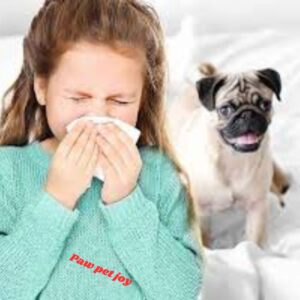Do you suffer from pet dander allergies? Here are six tips for reducing your reaction and making your home more dander-free.
Most People with Pet Allergies Are Allergic to Dander
Dander is a term for extremely small, often microscopic, bits of skin that are shed by animals with fur or feathers, including dogs, cats, mice, and birds. Humans also have dander, and it’s often called dandruff and usually shed from the head.
Pet dander allergies are a specific type of pet allergy – people can also be allergic to other proteins in an animal’s saliva or skin. These allergies are prevalent because dander can be pervasive and not only gets into the animal’s fur but also spreads to various surfaces around the house. Controlling the spread of dander, especially in a home with many soft surfaces like beds and couches, and carpets, can be a challenge.

Common Symptoms of a Pet Dander Allergy
There are a variety of symptoms that might show up if you are allergic to pet dander. These can range from very minor symptoms, such as a runny nose, congestion, or sneezing, to more severe reactions like difficulty breathing or swelling of the throat and nose. Other symptoms that can be caused by a pet dander allergy include pain in the face from sinus pressure, coughing or wheezing, irritation in the eyes (itchiness, redness, or excessive watering), or skin reactions like hives and rashes.
These symptoms are common for many types of allergies, so none of these are unique indicators that a person is allergic to pet dander specifically. It’s possible your pet is bringing in an allergen from the outdoors, such as grass or pollen, and their dander alone doesn’t actually cause a reaction.

Testing and Diagnosis of Pet Dander Allergies
If you notice that your allergies lessen when you are away from your pet and away from home (where their pet dander is concentrated), then it’s likely the cause of your symptoms. But even if you’re confident that this is the cause of your allergies, you should still visit a doctor and get tested. In addition to considering your symptoms and medical history and giving you a physical examination, your doctor will likely do a skin or blood test that can help identify your specific allergy. Your doctor might also refer you to a specialty allergist for this testing and further care.
With a simple skin prick test, you can find out within 20 minutes or less if your pet is the reason for your symptoms. A small amount of the allergen is placed on the skin and then the skin is pricked so the allergen seeps into the skin. Your doctor then monitors that area for a reaction.
6 Tips for Reducing Your Pet Dander Allergies
For those who suffer from pet dander allergies, this love for animals can come at a cost. Pet dander – tiny flecks of skin shed by cats, dogs, and other animals – can trigger allergic reactions ranging from sneezing and watery eyes to more severe symptoms like asthma attacks.
If your pet dander allergy is not too severe, there are many ways you can manage your home and lifestyle to avoid symptoms. Some strategies include:
We’ll explore six tips for dealing with pet dander allergies. From simple lifestyle adjustments to more targeted cleaning strategies, we’ll cover a range of techniques to help you reduce your exposure to pet dander and alleviate your allergy symptoms. By following these tips, you can create a healthier and more comfortable environment for yourself while still enjoying the companionship of your beloved pets.
- Creating pet-free zones in the house Pet Dander Allergies
- Reducing carpets and soft surfaces Pet Dander Allergies
- Making it easy to wash fabrics in your home Pet Dander Allergies
- Bathing your pet regularly Pet Dander Allergies
- Grooming and brushing your pet outside the house regularly (or having a family member do so)
- Wearing a mask while vacuuming Pet Dander Allergies
Establish a Pet-Free Zone to Provide Relief
If you’re suffering from pet dander allergies, establishing a pet-free zone can provide much-needed relief. This designated area in your home is a space where your pet is not allowed to roam freely, helping to reduce your exposure to allergens that may trigger your symptoms.
When setting up a pet-free zone, it’s important to consider a few key factors. Firstly, choose a well-ventilated room with hardwood or tile floors that are easier to clean compared to carpeted areas where dander can easily accumulate. Keep windows open for fresh air circulation and invest in an air purifier with a HEPA filter to help capture pet dander and other allergens in the air.
Remove any items that may attract pet dander such as upholstered furniture, rugs, and curtains. Opt for washable, allergy-proof covers for bedding and pillows to prevent allergens from settling in these areas. Regularly wash your pet’s bedding and toys to reduce the amount of dander they carry around the house.
Establishing a pet-free zone doesn’t mean completely isolating your pet. Create a comfortable space for them in a different area of the house, such as a designated pet room or a crate with their favorite toys and bedding. Make sure they have access to food, water, and a litter box (if applicable) in their designated area to ensure their comfort and well-being.
It’s essential to regularly clean and maintain the pet-free zone to keep allergens at bay. Vacuum and dust frequently using a HEPA-filtered vacuum cleaner and damp cloth to capture and trap pet dander. Wash hard surfaces with a mild detergent and hot water to remove any lingering allergens. Consider using non-toxic cleaning products to minimize exposure to harsh chemicals that may trigger allergies.

Reduce Carpets and Soft Surfaces in the Home
Many people love the cozy feeling that carpets and soft surfaces bring to a home. However, if you suffer from pet dander allergies, these soft surfaces can be a breeding ground for allergens. Pet dander can easily stick to carpets, rugs, and upholstered furniture, making it difficult to fully eliminate allergens from your living space.
One way to deal with pet dander allergies is to reduce the amount of carpets and soft surfaces in your home. Hardwood floors or tile are much easier to clean and don’t trap allergens as easily as carpets do. If you do have carpets in your home, it’s important to vacuum regularly with a HEPA filter vacuum to remove as much pet dander as possible. However, even with regular vacuuming, it can be difficult to fully eliminate allergens from carpets.
Another option is to invest in washable area rugs instead of wall-to-wall carpeting. Washable rugs can be easily cleaned, reducing the amount of pet dander that accumulates in your home. Additionally, using washable throw blankets on upholstered furniture can help reduce allergens as well.
In addition to reducing carpets and soft surfaces in your home, it’s important to regularly wash bedding and curtains to remove pet dander. Bedding can easily trap allergens, so washing sheets, pillowcases, and comforters regularly can help reduce allergens in your sleeping area. Curtains can also collect pet dander, so washing them or switching to blinds can help reduce allergens in your home.
If you have pets, it’s also important to regularly groom them to reduce the amount of dander they produce. Brushing your pets outside can help prevent pet dander from accumulating in your home. Additionally, bathing your pets regularly can help reduce allergens as well.
Investing in a high-quality air purifier can also help reduce pet dander in your home. Air purifiers with HEPA filters can help trap pet dander and other allergens, improving the air quality in your home. Place air purifiers in common areas where you and your pets spend the most time to help reduce allergens.
By reducing carpets and soft surfaces in your home, regularly washing bedding and curtains, grooming your pets, and using an air purifier, you can effectively reduce pet dander allergens in your living space. These tips can help alleviate symptoms of pet dander allergies and create a more comfortable environment for you and your family.

Make It Easy to Wash Soft Surfaces and Fabrics in the Home
Many people underestimate the impact that soft surfaces and fabrics in the home can have on pet dander allergies. These materials can easily trap and hold onto dander, making it difficult to fully eliminate allergens from your living space. However, there are several strategies you can implement to make it easier to wash soft surfaces and fabrics in your home.
One of the first steps you should take is to regularly wash any bedding, including sheets, blankets, and pillowcases, that come into contact with your pet. These items can quickly become covered in dander, so it’s important to wash them frequently in hot water to remove allergens. Additionally, consider using allergen-proof covers on your pillows and mattresses to create a barrier between you and any dander that may be present.
Another key area to focus on is upholstered furniture. Couches, chairs, and decorative pillows can all harbor pet dander, so it’s essential to regularly vacuum these surfaces with a high-efficiency particulate air (HEPA) filter to capture and remove allergens. In addition to vacuuming, consider steam cleaning upholstered furniture periodically to thoroughly clean and sanitize the fabric.
Curtains and drapes are often overlooked when it comes to managing pet dander allergies. These soft surfaces can easily trap dander and other allergens, so it’s important to launder them regularly to keep your living space allergen-free. If your curtains are not machine washable, consider taking them to a professional cleaner for thorough cleaning.
Also, don’t forget about rugs and carpets. These soft surfaces can quickly become overwhelmed with pet dander, making it challenging to keep your home allergen-free. Vacuum rugs and carpets frequently with a HEPA filter to capture dander and other allergens. Consider steam cleaning these surfaces periodically to deep clean and remove trapped allergens.
Soft toys and pet bedding are additional sources of pet dander in the home. Make it a habit to regularly wash your pet’s toys and bedding with hot water and fragrance-free detergent to remove allergens. Additionally, consider purchasing washable toys and bedding to make cleaning these items easier and more convenient.
Implementing these strategies to make it easier to wash soft surfaces and fabrics in your home can make a significant difference in managing pet dander allergies. By regularly cleaning and laundering these materials, you can create a healthier living environment for both you and your pet. Don’t underestimate the impact that these soft surfaces can have on your allergies – take proactive steps to keep them clean and allergen-free.
Bath Your Pet Thoroughly and Regularly
One of the most effective ways to reduce pet dander in your home is to bathe your pet thoroughly and regularly. Bathing your pet helps to remove loose fur, dirt, and dander from their coat, preventing it from floating around your home and triggering allergic reactions.
When it comes to bathing your pet, it’s important to use a gentle pet shampoo that is specifically designed for their skin and coat type. Avoid using harsh human shampoos, as they can strip your pet’s skin of its natural oils and cause irritation. Instead, opt for a mild, hypoallergenic shampoo that will help to cleanse your pet’s coat without irritating their skin.
Before you bathe your pet, it’s a good idea to brush them thoroughly to remove any loose fur and tangles. This will not only help to reduce shedding and dander, but it will also make the bathing process easier and more effective. Be sure to use a pet-friendly brush or comb that is designed to remove loose hair without causing discomfort to your furry friend.
When bathing your pet, be sure to use lukewarm water and avoid getting water in their ears and eyes. Gently lather the shampoo into your pet’s coat, starting at their neck and working your way down to their tail. Be sure to rinse their coat thoroughly to remove all traces of shampoo, as leaving residue behind can cause skin irritation.
After bathing your pet, be sure to dry them thoroughly with a clean towel. Avoid using a hair dryer, as the heat and noise can be stressful for your pet. Instead, gently pat them dry and allow them to air dry naturally. If your pet has a long coat, you may want to consider using a pet-friendly brush or comb to help remove tangles and prevent matting.
By bathing and grooming your pet regularly, you can help to reduce pet dander in your home and alleviate symptoms of pet allergies. Not only will your pet look and feel great, but you’ll also be creating a healthier environment for yourself and your family. So, make bath time a regular part of your pet care routine and enjoy a dander-free home!

Groom Your Pet Outdoors and Enlist Help If Needed
Grooming your pet outdoors can be a great way to help manage pet dander allergies. When you groom your pet indoors, allergens can easily spread throughout your home and exacerbate your symptoms. By grooming your pet outside, you can help keep dander and other allergens from building up in your living spaces.
If you have a yard or outdoor space where you can groom your pet, take advantage of it. Set up an area with a hose or tub for bathing, a brush for grooming, and a towel for drying. This way, any dander or allergens that are released during grooming will be less likely to linger in your home.
If you don’t have access to an outdoor space for grooming, consider enlisting the help of a friend or family member who does. They can help you groom your pet in their yard or outdoor area, reducing the amount of allergens that are brought into your home.
If you’re unable to groom your pet outdoors or find someone to help, you can also consider taking your pet to a professional groomer. Professional groomers have the tools and experience to effectively remove dander and other allergens from your pet’s coat. Make sure to communicate with the groomer about your pet dander allergies so they can take any necessary precautions.
Another option is to look for mobile pet grooming services that can come to your home. These services often have specialized equipment that can help reduce dander and allergens, while still allowing your pet to be groomed in a more controlled environment.
Regardless of where you choose to groom your pet, make sure to groom them regularly to keep dander and allergens at bay. Brushing your pet’s coat can help remove loose fur and dander, while bathing can help wash away any allergens that may be clinging to their skin.
Remember, grooming your pet outdoors and enlisting help if needed are just a few strategies for managing pet dander allergies. It’s important to also keep up with regular cleaning and maintenance in your home, such as vacuuming, dusting, and washing bedding, to reduce allergens. By taking proactive steps to manage pet dander, you can help keep your allergies under control and enjoy a happier, healthier life with your furry friend.
Wear a Mask While Vacuuming, or Leave the House While Someone Else Does It
Pet dander can be a major trigger for allergies in those who are sensitive to it. If you find that vacuuming stirs up too many pet allergens and causes your symptoms to flare up, consider wearing a mask while vacuuming. A mask can help to filter out some of the allergens, reducing your exposure while you clean.
If wearing a mask while vacuuming is not enough to prevent your symptoms from flaring up, consider leaving the house while someone else does the vacuuming. This way, you can avoid direct contact with the pet dander that is being stirred up during the cleaning process. Make sure to keep windows open to allow fresh air to circulate and help remove any airborne allergens from the house.
Leaving the house while someone else vacuums can be a good option if you have severe allergies or if you find that vacuuming triggers a strong reaction. It may also be a good idea to stay out of the house for a little while after the cleaning is done to allow any remaining allergens to settle. Consider taking a walk or running errands while the vacuuming is being done, and return to a clean and allergen-free home when you are ready.
In addition to wearing a mask or leaving the house while vacuuming, consider using a vacuum cleaner with a HEPA filter. HEPA filters are designed to trap small particles, including pet dander and other allergens, and can help to reduce the amount of allergens that are released into the air while you clean. Regularly changing the filter in your vacuum cleaner can also help to improve its efficiency in capturing allergens.
Another tip for dealing with pet dander allergies while vacuuming is to vacuum regularly. Vacuuming the floors, carpets, and upholstery in your home on a regular basis can help to reduce the amount of pet dander that accumulates and minimize your exposure to allergens. Consider vacuuming at least once a week, or more frequently if you have pets that shed a lot.
To further minimize your exposure to pet dander while vacuuming, consider using a vacuum cleaner with a pet-specific attachment. These attachments are designed to remove pet hair and dander from surfaces more effectively than a regular vacuum cleaner. Using a pet-specific attachment can help to ensure that you are thoroughly cleaning your home and reducing the amount of allergens in the air.
By following these tips, you can help to minimize your exposure to pet dander while vacuuming and reduce the risk of allergic reactions. Remember to wear a mask, use a vacuum cleaner with a HEPA filter, vacuum regularly, use pet-specific attachments, and consider using a vacuum cleaner with a sealed system to keep your home clean and allergen-free.

What is pet dander?
Pet dander consists of tiny, often microscopic flecks of skin shed by cats, dogs, rodents, birds, and other animals with fur or feathers. It can also include proteins from saliva, urine, and feces that stick to the skin and fur of pets.
What are the symptoms of pet dander allergies?
Symptoms of pet dander allergies can vary but commonly include sneezing, runny or stuffy nose, itchy or watery eyes, coughing, wheezing, chest tightness, and skin reactions such as rashes or hives. In severe cases, it can trigger asthma attacks.
Can pet dander allergies develop over time?
Yes, it’s possible for someone to develop pet dander allergies even if they have not experienced them before. Exposure to pets over time can sensitize the immune system, leading to the development of allergic reactions. Additionally, changes in the immune system due to factors like aging or hormonal changes can also trigger allergies later in life.
Are certain pets hypoallergenic?
While no pet is completely hypoallergenic, some breeds are less likely to trigger allergies in sensitive individuals. These breeds typically produce fewer allergens or shed less dander. Examples include certain breeds of dogs like poodles, bichon fries, and some breeds of cats such as the Siberian or Balinese. However, individual reactions vary, and what works for one person may not work for another.
How can I manage pet dander allergies?
Managing pet dander allergies involves a combination of strategies. These include keeping pets out of bedrooms and other areas where you spend a lot of time, regularly bathing and grooming pets to reduce dander, using high-efficiency particulate air (HEPA) filters in your home, vacuuming frequently with a HEPA filter-equipped vacuum cleaner, and considering allergy medications or immunotherapy (allergy shots) under the guidance of a healthcare professional.
Conclusion:
Dealing with pet dander allergies can be challenging, but with the right strategies in place, it is possible to manage your symptoms effectively. By implementing these six tips – from keeping your home clean to choosing hypoallergenic pets – you can create a comfortable and allergen-free environment for both you and your furry friends. Remember, with a little effort and awareness, you can enjoy the companionship of pets without the discomfort of allergies.

Leave A Comment